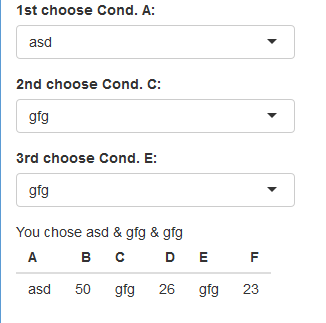I have a challenge in the below code. I am trying to reduce the code by incorporating Selectinput under for Loop. I have a data frame. I tried with the below code but it is not getting executed
df <- structure(list(A = structure(c(1L, 4L, 6L, 1L, 8L, 2L, 7L, 3L,
5L, 5L, 1L, 8L, 2L, 7L, 2L), .Label = c("asd", "dfg", "fgdsgd",
"fsd", "gdfgd", "gs", "sdfg", "sf"), class = "factor"), B = c(29L,
24L, 46L, 50L, 43L, 29L, 32L, 24L, 35L, 39L, 33L, 47L, 53L, 26L,
31L), C = structure(c(8L, 5L, 1L, 6L, 3L, 2L, 9L, 7L, 6L, 3L,
2L, 9L, 8L, 8L, 4L), .Label = c("asd", "er", "fg", "gf", "gfd",
"gfg", "qw", "sf", "tr"), class = "factor"), D = c(36L, 56L,
39L, 26L, 56L, 35L, 27L, 31L, 33L, 45L, 34L, 27L, 43L, 40L, 56L
), E = structure(c(8L, 5L, 1L, 6L, 3L, 2L, 9L, 7L, 6L, 3L, 2L,
9L, 8L, 8L, 4L), .Label = c("asd", "er", "fg", "gf", "gfd", "gfg",
"qw", "sf", "tr"), class = "factor"), F = c(44L, 34L, 37L, 23L,
37L, 51L, 28L, 36L, 33L, 31L, 39L, 43L, 25L, 37L, 43L)), class =
"data.frame", row.names = c(NA, -15L))
shinyApp(
ui = fluidPage(
selectInput("state", "Choose a state:",for(i in names(Filter(is.factor,df))){
list(i = c(levels(df[,i])))
),
textOutput("result")
),
server = function(input, output) {
output$result <- renderText({
paste("You chose", input$state)
})
}
)
shinyApp(ui, server)
In this dataset , there are 3 factors that are "A" "C" "E". So I need to put them as a SelectInput with its factors as drop down. For example,
Column A has factor (asd,fsd,gs,asd,sf,dfg,sdfg,fgdsgd,gdfgd,gdfgd,asd,sf, dfg,sdfg,dfg). I need these as drop down. I can make this happen. But i need this under for loop so that there is no need to enter for all factors. Hope my points are clear and makes sense
